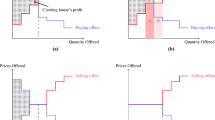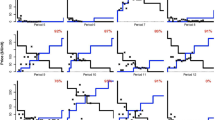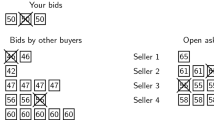Abstract
This paper is the first experimental study of the effects of competition and adverse selection on the performance of market maker (MM-) markets. Information distribution may is either symmetric or heterogeneous. MM-markets are either monopolistic (the specialist markets), or competitive (the multi MM-market). Welfare comparisons are with respect to a continuous double auction (DA-) market. Informed subjects receive an imperfect signal of the true state of the world. We find three main results. First, competition among market makers significantly reduces the bid-ask spread, and increases transaction volume. Second, competition among market makers induces competitive undercutting, yielding net trading losses for market makers as a group in most periods. Third, from the perspective of uninformed traders, a competing MM-regime is optimal, since it minimizes their expected trading losses.
Similar content being viewed by others
References
Admati, A. and Pfleiderer, P. (1989). “Divide and Conquer: A Theory of Intraday and Day-of-the-week Mean Effects.” Review of Financial Studies. 2, 189–224.
Amihud, Y. and Mendelson, H. (1986). “Asset Pricing and the Bid-Ask Spread.” Journal of Financial Economics. 17, 223–249.
Bloomfield, R. (1996). “Quotes, Prices and Estimates in a Laboratory Market.” Journal of Finance. 51, 1791–1808.
Bloomfield, R. and O'Hara, M. (1999). “Market Transparency: WhoWins and Who Loses?” Review of Financial Studies. 12, 5–35.
Bloomfield, R. and O'Hara, M. (2000). “Can Transparent Markets Survive?” Journal of Financial Economics. 55, 425–459.
Börsenzeitung, (1995). Zur führenden Börsenorganisation in der europäischen Zeitzone werden, No. 63, March 30, 8.
Christie, W. and Schultz, P. (1994). “Why Do NASDAQ Market Makers Avoid Odd-Eighth Quotes?” Journal of Finance. 49, 1813–1840.
Christie, W., Harris, J., and Schultz, P. (1994). “Why Did NASDAQ Market Makers Stop Avoiding Odd-Eighth Quotes?” Journal of Finance. 49, 1841–1860.
Financial Economists Roundtable (1996). “Statement on the Structure of the NASDAQ Stock Market.” Journal of Financial Services Research. 10, 105–107.
Financial Times. (1997). Derivatives: Fierce battle rages for market share (author: Samer Iskander), June 27.
Freihube, T., Kehr, C., and Krahnen, J.P. (1999). “Was leisten die Kursmakler: Eine empirische Untersuchung der Frankfurter Wertpapierbörse.” Kredit und Kapital. 32, 426–460.
Friedman, D. (1984). “On the Efficiency of Experimental Double Auction Markets.” American Economic Review. 74, 60–72.
Friedman, D. (1991). “A Simple Testable Model of Double Auction Markets.” Journal of Economic Behavior and Organization. 15, 47–70.
Friedman, D. (1993). “Privileged Traders and Asset Market Efficiency: A Laboratory Study.” Journal of Financial and Quantitative Analysis. 28, 515–534.
Garman, M. (1976). “Market Microstructure.” Journal of Financial Economics. 3, 257–275.
Glosten, L.R. (1989). “Insider Trading, Liquidity, and the Role of the Monopolist Specialist.” Journal of Business. 62, 211–235.
Glosten, L.R. and Harris, L.E. (1988). “Estimating the Components of the Bid/Ask Spread.” Journal of Financial Economics. 21, 123–142.
Glosten, L.R. and Milgrom, P. (1985). “Bid, Ask, and Transaction Prices in an Specialist Market with Heterogeneously Informed Traders.” Journal of Financial Economics. 13, 71–100.
Hasbrouck, J. (1988). “Trades, Quotes, Inventory, and Information.” Journal of Financial Economics. 22, 229–252.
Ho, T. and Stoll, H. (1981). “Optimal Market Maker Pricing under Transactions and Return Uncertainty.” Journal of Financial Economics. 9, 47–73.
Ho, T. and Macris, R.G. (1985). “Market Making and the Changing Structure of the Securities Industries.” In Y. Amihud, T.S.Y. Ho, and R.A. Schwartz (eds.), Market Making and the Changing Structure of the Securities Industry, Lexington: MA, 41–66.
Huang, R. and Stoll, H. (1996). “Dealer versus Auction Markets: A Paired Comparison of Execution Costs on NASDAQ and the NYSE.” Journal of Financial Economics. 41, 313–357.
Krahnen, J.P. (1993). “Market Makers and Traders in an Experimental Stock Market.” Working Paper, University of Giessen.
Krahnen, J.P., Rieck, C., and Theissen, E. (1999). “Designing an Experimental Asset Market.” In W. Bühler, H. Hax, and R. Schmidt (eds.), Empirical Research on the German Capital Market, Heidelberg: Springer, 27–54.
Krahnen, J.P. and Weber, M. (1999). “Does Information Aggregation Depend on Market Structure? Market Makers versus Double Auction.” Zeitschrift f¨ur Wirtschafts-und Sozialwissenschaften. 119, 1–21.
Kyle, A. (1985). “Continuous Auctions and Insider Trading.” Econometrica. 53, 1315–1336
Kyle, A.S. (1989). “Informed Speculation with Imperfect Competition.” Review of Economic Studies. 56, 317–355.
Lamoureux, C.G. and Schnitzlein, C.R. (1997). “When it's not the only Game in Town.” Journal of Finance. 52, 683–712.
Leach, J.C. and Madhavan, A.N. (1993). “Price Experimentation and Security Market Structure.” Review of Financial Studies. 6, 375–404.
LeRoy, S.F. (1989). “Efficient Capital Markets and Martingales.” Journal of Economic Literature. 27, 1583–1621.
Milgrom, P. and Stokey, N. (1982). “Information, Trade and Common Knowledge.” Journal of Economic Theory. 26, 17–27.
Madhavan, A. (1992). “Trading Mechanisms in Securities Markets.” Journal of Finance. 47, 607–642.
Madhavan, A. and Sofianos, G. (1994). “Auction and Market Maker Markets: An Empirical Analysis of NYSE Specialist Trading.” NYSE Working Paper #94–01.
O'Hara, M. (1995). Market Microstructure Theory. Cambridge, Mass.: Blackwell Publishers.
Pagano, M. and Roell, A. (1996). “Transparency and Liquidity: A Comparison of Auction and Market Maker Makets with Informed Trading.” Journal of Finance. 51, 579–612.
Plott, Charles R. and Sunder, S. (1982). “Efficiency of Experimental Security Markets with Insider Information: An Application of Rational-Expectations Models.” Journal of Political Economy. 90(4), 663–698.
Plott, Charles R. and Sunder, S. (1988). “Rational Expectations and the Aggregation of Diverse Information in Laboratory Security Markets.” Econometrica. 56, 1085–1118.
Plott, C.R. and Gray, P. (1990). “The Multiple Unit Double Auction.” Journal of Economic Behavior and Organization. 13, 245–258.
Seppi, D.J. (1997). “Liquidity Provision with Limit Orders and a Strategic Specialist.” Review of Financial Studies. 10, 103–150.
Spulber, D.F. (1996). “Marketmicrostructure and Intermediation.” Journal of Economic Perspectives. 10(3), 135–152.
Theissen, E. (1996). “Market Structure and the Aggregation of Information: An Experimental Investigation.” Working paper, University of Frankfurt.
Wahal, S. (1997). “Entry, Exit, Market Makers, and the Bid-Ask-Spread.” Review of Financial Studies. 10, 871–901.
Author information
Authors and Affiliations
Rights and permissions
About this article
Cite this article
Krahnen, J.P., Weber, M. Marketmaking in the Laboratory: Does Competition Matter?. Experimental Economics 4, 55–85 (2001). https://doi.org/10.1023/A:1011493421952
Issue Date:
DOI: https://doi.org/10.1023/A:1011493421952




